Wanda Landowska – About the rediscovery of the harpsichord
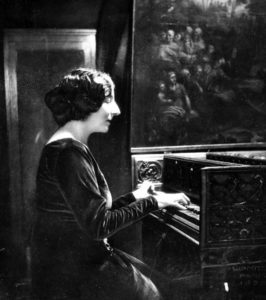
Wanda Landowska was one of the most outstanding musicians of the 20th century, achieving international fame both as a pianist and as a harpsichordist. Her career spanned more than six decades and she is considered a pioneer of historical performance practice and one of the most important interpreters of the music of the Baroque era, particularly the works of Johann Sebastian Bach (1685 – 1750). However, Landowska was not only a brilliant musician, but also an inspirational educator and a dedicated researcher who devoted her life to the rediscovery and revival of ancient forms of music. It is also her contribution that the harpsichord has found its place in music again.
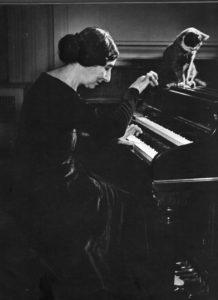
Wanda Landowska was born on July 5, 1879 in Warsaw, Poland and grew up in a musical family. Her father was a lawyer and music teacher who began teaching her when she was four years old. One of her first teachers was Jan Kleczyński (1837 – 1895). At the age of six she was admitted to the Warsaw Music Academy and received piano and music theory lessons from Aleksander Michałowski (1851 – 1938), who was a close friend of Karol Mikuli (1819 – 1897), a student of Frédéric Chopin (1810 – 1849).
After graduating from the Warsaw Conservatory at the age of 14, Landowska moved to Berlin in 1896 to continue her education. There she studied piano with Moritz Moszkowski (1854 – 1925), Theodor Leschetizky (1830 – 1915) and music theory with Karl Heinrich Barth (1847 – 1922) and Hugo Riemann (1849 – 1919). She received composition lessons from Heinrich Urban (1837 – 1901). She also met there her future husband Henri Lew (1874 – 1919). The couple married in Paris on May 10, 1900 and moved there, where Wanda Landowska studied with Gabriel Fauré (1845 – 1924).
During her time in Berlin and her later studies in Paris, Landowska discovered her passion for the harpsichord, which was an instrument that had been forgotten by that time. She began collecting and restoring historical harpsichords and soon began playing these instruments regularly in concerts. From 1903 she integrated the harpsichord as an integral part of her concerts and explained the differences and playing techniques between the two instruments to the audience. This led to a growing interest in the instrument and Wanda Landowska expanded her repertoire more and more towards Early Music. As the interest in the “new” instrument grew, so did composers’ interest, too. For example, Manuel de Falla (1876 – 1946) and Francis Poulenc (1899 – 1963) composed pieces for the harpsichord (for example the Concert champêtre, which Poulenc composed in 1927/28 and dedicated to Wanda Landowska).
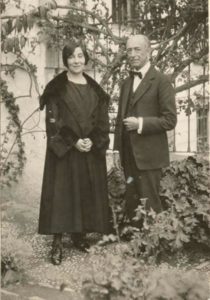
Wanda Landowska and Manuel de Falla
On a review of one of their concerts in Vienna on November 23, 1904 the critics wrote:
„Im kleinen Musikvereinssaal veranstaltete die Klaviervirtuosin Wanda Landowska aus Paris letzten Mittwoch einen interessanten Abend. Auf dem Klavier und dem historischen Clavecin trug sie Kompositionen von J. S. Bach und mehreren seiner Zeitgenossen vor. Wanda Landowska verfügt über eine brillante Technik und eine seltene Weichheit des Anschlags, die namentlich in Bachs Suite Anglais und in Claude Daquins ,Le Coucou‘ glänzend zur Geltung kamen. Mit Spannung harrte das Auditorium der Vorträge auf dem Clavecin. Auf dem Podium stand das von Pleyel in Paris gebaute Instrument, das trotz seiner acht Füße einen sehr graziösen Eindruck macht. Die Künstlerin handhabt übrigens das Clavecin, es hat zwei Manuale und sechs Pedale, mit ebensolcher künstlerischer Fertigkeit wie das Klavier. Man glaubt sich bei den Klängen des Instruments in einen Salon des achtzehnten Jahrhunderts versetzt, und schließt man die Augen, dann schweben auch schon die reizenden Gestalten in Bauschröcken und Chemisette mit den gepuderten Perücken im Menuettschritt vorüber. Das Instrument hat einen überaus volltönenden Klang. Die Tonfarbe schwebt zwischen Harfe und Zymbal. Wundernett kamen unter anderem Händels ,Grobschmiedvariationen‘ heraus, deren Vortrag der Künstlerin wie alle übrigen Nummern wärmsten Beifall brachte“ (see: Neue Freie Presse 26. Nov. 1904, p. 10).
However, the growing interest in the harpsichord began to create a problem, as there was only a limited number of instruments available and playable. In the past, the harpsichord was considered a curiosity, obsolete and unfashionable. The piano was the ultimate instrument and could be used universally. Wanda Landowska collected historical instruments and had an interesting collection of historic harpsichords, which she also used for concerts. But where did her interest in the harpsichord come from?
An important milestone was the World Exhibition of 1889 in Paris. Wanda Landowska was only 10 years old at that time, but was already advanced in her musical education and interested. Three harpsichords specially made for the exhibition were exhibited in Paris:
- two-manual harpsichord by Louis Tomasini
- two-manual harpsichord by Pleyel
- two-manual harpsichord by Erard
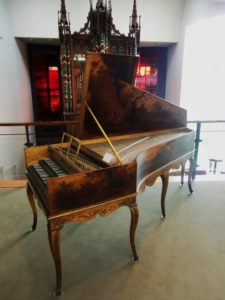
Harpsichord made by Louis Tomasini for the Exposition Universelle of 1889 in Paris
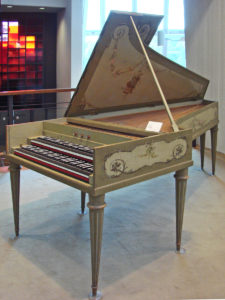
Harpsichord made by Erard for the Exposition Universelle of 1889 in Paris
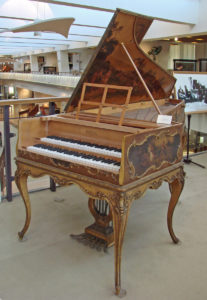
Harpsichord by Pleyel for the Exposition Universelle of 1889 in Paris
These instruments caused a sensation, as the spirit of the times and fashion had previously been reserved for the modern piano. Interest in these instruments grew and the harpsichord received more and more attention from musicians, musicologists and in publications, but the triumph of the piano remained some time before the harpsichord could establish itself again.
1896 marks another important point in Wanda Landowska’s life, when she visited the Royal Collection of Ancient Musical Instruments in Berlin together with Bogumil Zepler (1858 – 1918), where she became acquainted with the “Bach harpsichord” (Cat. No. 316). The harpsichord in the Berlin collection, which is probably built by Johann Heinrich Harrass (1665 – 1714), is said to have belonged to Wilhelm Friedemann Bach (1710 – 1784), who is said to have inherited it from his father Johann Sebastian Bach (but there is no proof of this). However, the encounter with this instrument had a lasting effect on Wanda Landowska and had an enormous influence on her further career. The “Bach harpsichord” has 3 registers (16′, 8′ and 4′). The 16′ register is unusual and was used mostly by harpsichord makers in Hamburg, Saxony and Thuringia. We can only speculate why this harpsichord in the Berlin collection made such a lasting impression on Wanda Landowska: was it the nimbus of the composer Johann Sebastian Bach or the disposition or something else?
Due to the interest and the growing demand, Wanda Landowska approached the traditional French company Pleyel, which had already presented an instrument at the 1889 World Exhibition. Landowska’s ideas of sound (especially the use of a 16′ register) and her experience as a musician bore fruit in a productive collaboration and so Pleyel started manufacturing harpsichords in 1912. The instruments were signed with Wanda Landowska’s name – the “Landowska model” was born and had a lasting influence on modern harpsichord construction in the 20th century. All instruments were provided with a steel frame and their construction was derived from modern piano construction. The keys were heavy to play and the registers could be switched with the help of pedals. The harpsichords were produced in two versions: a model with six pedals – without nasal stops – and a model with seven pedals. In the early days, the instruments did not have a protruding keyboard, which was later changed because the audience at concerts wanted to see the harpsichordist’s hands. In some cases, the front right-hand side was subsequently shortened in order to do justice to the audience. Some of Pleyel’s harpsichords were painted and decorated as special versions, similar to the popular “Art Case grand pianos”, by well-known artists (e.g. by Bernard Naudin (1876 – 1946)). On the VI. German Bach Festival of the New Bach Society from June 15 to 17, 1912 in Breslau, Landowska presented the new Pleyel harpsichord (“Grand Modèle de Concert”) to the public for the first time.
Due to Landowska’s popularity with playing a huge amount of concerts, recordings and her presence in magazines and newspapers, the harpsichord experienced an unprecedented boom. In 1913 the first professorship for harpsichord was established in Berlin and Wanda Landowska was appointed as the first female professor. But there was not only positive feedback on the revival of the harpsichord, also opponents who dealt critically with the rediscovered instrument. The limited dynamics and reduced timbres were often criticized.
During this time, many instrument makers were involved in the construction of the rediscovered type of instrument in a wide variety of ways and there were major differences in structure, sound and workmanship. For example, one of the first instrument makers in Hamburg was Walther Ebeloe. He made the first harpsichords in Hamburg in the 20th century. Since the harpsichord was hardly a major research object at the time, there were little knowledge and many instrument makers used modern piano construction and thus constructed new instruments that represent a kind of hybrid: the sound generation of the harpsichord with jacks and quills in combination with experience and innovations in modern piano construction, as well as with modern materials. Partly motivated to build a reliable and perhaps also “improved” instrument, instruments were created that sound little in common with a historical instrument, but in terms of music history they play an important role in preparing the way for today’s historical performance practice. An instrument by Walther Ebeloe from 1939 is in the Eric Feller Collection – For detailed information about this instrument, please click here!
Wanda Landowska’s harpsichord, developed in collaboration with Pleyel, long shaped the 20th century conception of the sound of plucked instruments. It was a role model for many instrument makers until the 1970s, when a change took place, from the “Rastenbauweise” (industrial/serial construction) to the historical construction, which has become the standard in historical performance practice today.
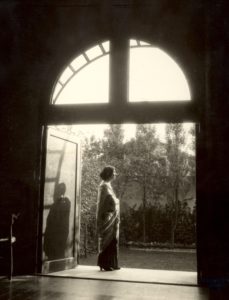
„Temple de la Musique Ancienne“ – Wanda Landowska at the entrance to her concert hall in Saint-Leu-la-Forêt
After Wanda Landowska settled in Saint-Leu-la-Forêt, not far from Paris, she founded the “École de Musique Ancienne” there, where she held annual summer courses and concerts. The concerts had become so popular that a railway connection was established. Her estate in Saint-Leu-la-Forêt was equipped with a specially built concert hall, which she herself called the “Temple de la Musique Ancienne“. In addition to her Pleyel harpsichords, she also housed her precious collection of original historical instruments (harpsichords, spinets, clavichords, organs…) there.
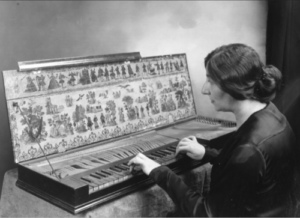
Wanda Landowska playing one of her historic clavichords from her collection
Among them were instruments by Andreas Ruckers and other renowned instrument makers as well as a piano by Juan Bauza, which Frédéric Chopin played during his stay on Mallorca. In addition to the collection of musical instruments, Wanda Landowska had an extensive library of sheet music and manuscripts. In June 1940, she had to flee from the German troops, leaving her collection behind. Employees of the “Sonderstab Musik” confiscated the instruments left in Landowska’s house and transported them by truck to Berlin on 20 September 1940. All the musical possessions were scattered and some were destroyed in bombing raids. Some of the instruments turned up on the private art market or at auctions after 1945. For a detailed description of these events, please refer to the book by Willem de Vries “Sonderstab Musik: Organisierte Plünderungen in Westeuropa 1940-45“.
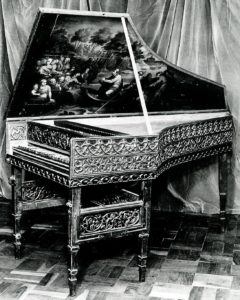
Italian Harpsichord 16th century – Collection Wanda Landowska
Overall, it is undeniable that Wanda Landowska has played a significant role in music history. She was a pioneer in the revival of harpsichord playing, and her pioneering research and passion for period instruments has had a profound influence on the modern interpretation of Baroque music. Her numerous recordings and writings have contributed to the rediscovery of the harpsichord as an important part of classical music. But Landowska’s legacy extends far beyond her musical accomplishments. She was one of the few women in the music industry to break barriers and set standards that are still relevant today. Her perseverance and pursuit of perfection have inspired and encouraged numerous musicians to pursue their own careers.
Wanda Landowska died on August 16, 1959 in Lakeville Connecticut USA.
Sources:
- Anthony, James R. Landowska: The Life and Work of the Great Harpsichordist. Amadeus Press, 2003.
- de Vries, Willem „Sonderstab Musik: Organisierte Plünderungen in Westeuropa 1940-45“.
- Gutmann, Peter. “Wanda Landowska: Revolutionary and Traditionalist.” New England Review and Bread Loaf Quarterly, vol. 26, no. 4, 2005, pp. 143-152.
- Heyer, John Hajdu. “Wanda Landowska and Early Music: A Personal View.” Early Music, vol. 14, no. 3, 1986, pp. 301-305.
- Hsu, Samuel. Wanda Landowska: The Woman and the Artist. Westport, CT: Greenwood Press, 1979.
- Joseph, Charles M. Wanda Landowska: The Search for Authenticity. Ithaca, NY: Cornell University Press, 1991.
- Kallberg, Jeffrey. “Landowska and Her Circle: The Shared Aesthetics of Music and Art.” In The Cambridge Companion to Wanda Landowska, edited by Mark Kroll, pp. 100-118. Cambridge University Press, 2021.
- Kroll, Mark. “The Artistry of Wanda Landowska.” Early Music America, vol. 6, no. 1, 2000, pp. 30-35.
- Landowska, Wanda. Landowska on Music. London: Gerald Duckworth & Co Ltd, 1964.
- Lawrence, D.H. “Wanda Landowska: The Pianist Who Made the Harpsichord Sing.” The Adelphi, June 1932, 148-156.
- Lubitz, Andrea. “Wanda Landowska and Her Collaborators in Interwar France.” In The Cambridge Companion to Wanda Landowska, edited by Mark Kroll, pp. 82-99. Cambridge University Press, 2021.
- Schmidt, Martin-Christian: Das 16’-Register im deutschen Cembalobau des 18. Jahrhunderts. Groteske oder beachtenswerte Erscheinung mit aufführungspraktischer Relevanz? In: Eszter Fontana (Hrsg.): Festschrift für Rainer Weber. Halle 1999, ISBN 3-932863-98-4. S. 63–72. (= Scripta Artium, Bd. 1. Schriftenreihe der Kunstsammlungen der Universität Leipzig).
- Oja, Carol J. Making Music Modern: New York in the 1920s. Oxford University Press, 2000.
- Owen, Barbara. “Wanda Landowska: A Pianist of the Harpsichord.” Early Music, vol. 4, no. 4, 1976, pp. 469-478.
- Piekarska-Duraj, Jolanta. Wanda Landowska: A Biography. Krakow: Polskie Wydawnictwo Muzyczne, 2012.
- Restout, Denise. Wanda Landowska: A Life in Music. New York: W.W. Norton & Company, 1981.
- Rosand, Ellen. “Wanda Landowska’s Aesthetic of Early Music.” Early Music, vol. 14, no. 3, 1986, pp. 306-312.
- Rosenblum, Sandra P. Landowska: Wanda Landowska Remembered. Hillsdale, NY: Pendragon Press, 2000.
- Rubin, Ruth J. “Wanda Landowska and the Harpsichord Revival.” In Women Making Music: The Western Art Tradition, 1150-1950, edited by Jane Bowers and Judith Tick, pp. 225-238. University of Illinois Press, 1986.
- Rosati, Vincent J. Wanda Landowska and Early Music: The Quest for Authenticity. Bloomington: Indiana University Press, 1998.
- Sauer, Theresa. “Wanda Landowska’s Contributions to the Early Music Revival.” The Musical Quarterly, vol. 81, no. 2, 1997, pp. 201-224.
© Eric Feller – Early Keyboard Collection – February 2023

